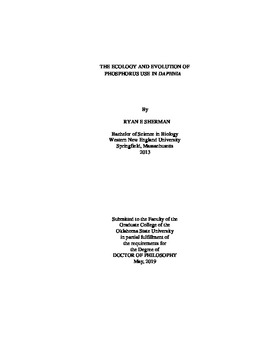| dc.contributor.advisor | Jeyasingh, Punidan | |
| dc.contributor.author | Sherman, Ryan E. | |
| dc.date.accessioned | 2019-10-25T19:51:45Z | |
| dc.date.available | 2019-10-25T19:51:45Z | |
| dc.date.issued | 2019-05-01 | |
| dc.identifier.uri | https://hdl.handle.net/11244/321578 | |
| dc.description.abstract | Understanding how populations respond to environmental change is an important challenge in contemporary biology. Ecological stoichiometry uses elemental composition of species to make predictions about success in defined conditions of elemental supply. Understanding the success of genotypes within a species as a function of their elemental composition is a first step in understanding the mechanisms generating and maintaining such variation in elemental content. I tested the extent to which P content, a pivotal element in biology, predicted growth and competition in several Daphnia genotypes. Further, I measured the use of 33P to understand the extent to which such parameters improved predictions. Genotypes showed significant variation in P content, 33P use, and growth rate. P content alone was a poor predictor of growth and competition. These results suggest that decomposing P content of an individual into physiological components of P use will improve stoichiometric models predicting growth. Further, I examined the link between phosphoglucose isomerase (PGI) and P-use efficiency (PUE). PGI genotype was shown to underlie differences in PUE in an F2 recombinant D. pulicaria population. Additionally, to better understand how multiple elements that comprise biomass covary with PUE, I quantified several elements that comprise biological tissues (i.e. ionomes) within the F2 population. Substantial variation in the ionomes of these genotypes were found, with several correlations among element concentrations. Finally, we know little about how the content and demand for these elements change across ontogeny. I tested how Daphnia ionomes vary across species and ontogeny. I found significant effects of age, species, and ontogeny on the ionome content of three species of Daphnia. Understanding the genetic basis of these patterns and the ecological implications should contribute to the integration of elements and traits, and the extent to which shifts in elemental contents impact eco-evolutionary dynamics. Ionomic datasets should be a useful diagnostic tool to decipher multi-element constraints on biomass production. | |
| dc.format | application/pdf | |
| dc.language | en_US | |
| dc.rights | Copyright is held by the author who has granted the Oklahoma State University Library the non-exclusive right to share this material in its institutional repository. Contact Digital Library Services at lib-dls@okstate.edu or 405-744-9161 for the permission policy on the use, reproduction or distribution of this material. | |
| dc.title | Ecology and Evolution of Phosphorus Use in Daphnia | |
| dc.contributor.committeeMember | Moen, Daniel | |
| dc.contributor.committeeMember | Campbell, Polly | |
| dc.contributor.committeeMember | Schoenknecht, Gerald | |
| osu.filename | Sherman_okstate_0664D_16205.pdf | |
| osu.accesstype | Open Access | |
| dc.type.genre | Dissertation | |
| dc.type.material | Text | |
| thesis.degree.discipline | Integrative Biology | |
| thesis.degree.grantor | Oklahoma State University | |
